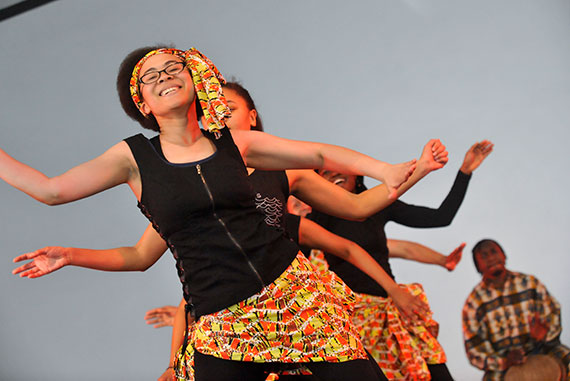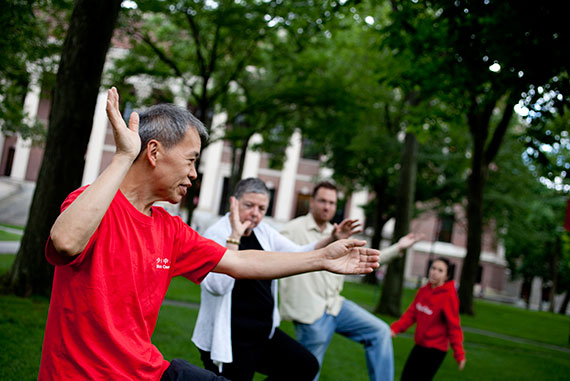Strength in movement
Researchers see potential role for dance in treating neurodegenerative disorders
Millions of Americans dance, recreationally or professionally. How many of those who ballroom dance, foxtrot, break dance, or line dance realize that they are doing something positive for their brains?
“There’s no question, anecdotally at least, that music has a very stimulating effect on physical activity,” said Daniel Tarsy, professor of neurology at Harvard Medical School (HMS) and director of the Parkinson’s Disease and Movement Disorders Center at Beth Israel Deaconess Medical Center. “And I think that applies to dance, as well.”
Scientists gave little thought to the neurological effects of dance until relatively recently, when researchers began to investigate the complex mental coordination that dance requires. In a 2008 article in Scientific American, a Columbia University neuroscientist posited that synchronizing music and movement constitutes a “pleasure double play.” Music stimulates the brain’s reward centers, while dance activates its sensory and motor circuits.
Studies using PET imaging have identified brain regions that contribute to learning and performing dances. These regions include the motor cortex, somatosensory cortex, basal ganglia, and cerebellum. The motor cortex is involved in the planning, control, and execution of voluntary movement. The somatosensory cortex, in the mid-region of the brain, is responsible for motor control and also plays a role in eye-hand coordination. The basal ganglia, a group of structures deep in the brain, works with other regions to smoothly coordinate movement, while the cerebellum integrates input from the brain and spinal cord and helps plan fine and complex motor actions.

While some imaging studies have shown which regions of the brain are activated by dance, others have explored how the physical and expressive elements of dance alter brain function. Much of the research on the physical activity associated with dance echoes findings on exercise, showing benefits that range from memory improvement to strengthened neural connections.
A 2003 study in the New England Journal of Medicine by researchers at the Albert Einstein College of Medicine showed that dance can decidedly improve brain health. The study investigated the effect leisure activities had on the risk of dementia in the elderly. The researchers looked at the impact of 11 different types of physical activity, including cycling, golf, swimming, and tennis, but found that only one — dance — lowered participants’ risk of dementia. The combination of mental effort and social interaction made the difference, according to the researchers.
In a small study undertaken in 2012, researchers at North Dakota’s Minot State University found that the Latin-style dance program known as Zumba improves mood and certain cognitive skills, such as visual recognition and decision-making. Other studies have shown that dance helps reduce stress, increases levels of the feel-good hormone serotonin, and helps develop new neural connections, especially in regions involved in executive function, long-term memory, and spatial recognition.
Dance has been found to be therapeutic for patients with Parkinson’s disease. More than one million people in this country are living with Parkinson’s, with 60,000 new cases annually, according to the Parkinson’s Disease Foundation. Parkinson’s belongs to a group of conditions called motor-system disorders, which develop when the dopamine-producing cells in the brain are lost. The chemical dopamine is an essential component of the brain’s system for controlling movement and coordination. As Parkinson’s disease progresses, an increasing number of these cells die off, drastically reducing the amount of dopamine available to the brain.
According to the foundation, the primary motor symptoms of Parkinson’s disease include bradykinesia (slowed movement), stiffness of the limbs and trunk, tremors, and impaired balance and coordination. It is these symptoms that dance may help alleviate.
“A lot of this research is observational, not hard science,” said Tarsy, “but it’s consistent and there’s a lot of it.”
Tarsy said that dance can be considered a form of rhythmic auditory stimulation (RAS). In RAS, a series of fixed rhythms are presented to patients, who are then asked to move to the rhythms. Studies of the effects this technique has on patients with Parkinson’s or other movement disorders have found significant improvements in gait and upper-extremity function. Although there have been no side-by-side scientific comparisons of RAS with either music or dance, Tarsy said people with Parkinson’s “speak and walk better if they have a steady rhythmic cue.”
At the Osher Center for Integrative Medicine at Brigham and Women’s Hospital, Peter Wayne, an assistant professor of medicine at HMS, studies the clinical effects of mind-body and complementary/alternative medicine practices on patients with chronic health conditions. He has conducted clinical trials designed to evaluate the safety and efficacy of tai chi for patients with Parkinson’s and other balance disorders. Tai chi is a Chinese martial art once used for self-defense but now performed as exercise. Wayne considers it a more ritualized, structured form of dance.

“The focus of our work is to take advantage of traditional exercises in which it’s implicit that the mind and body are connected more efficiently,” said Wayne. “Tai chi is one such exercise that we focus on because of its benefits for both balance and mental function.”
Research, he said, has shown that the increased susceptibility to falls seen in people who are aging or dealing with disorders like Parkinson’s can be mitigated by the practice of tai chi; it improves their strength and flexibility as well as their cognitive performance.
One such study appeared in 2012 in the New England Journal of Medicine. In it, a team of investigators led by a scientist at the Oregon Research Institute found that tai chi helped improve balance and prevent falls among people with mild to moderate Parkinson’s disease. After six months, those who practiced tai chi twice weekly were physically stronger and had better balance than those who did either weight training or stretching.
Under Tarsy’s direction, Beth Israel Deaconess has initiated several wellness programs, including ones that feature tai chi, Zumba, yoga, and drumming, designed to help people manage the symptoms of Parkinson’s disease. Although it is still unclear to what extent these programs benefit patients, Tarsy said there is evidence that such activities as dance and tai chi can stabilize the effects of the disease and slow the degree to which everyday movement is affected.




